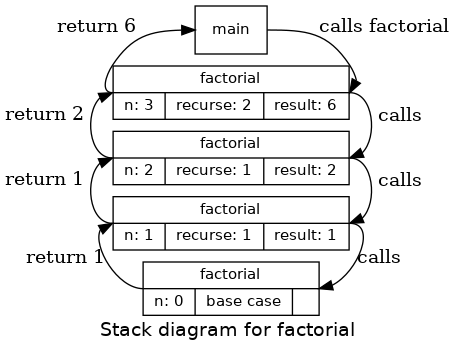6.4. More recursion¶
So far we have only learned a small subset of C++, but you might be interested to know that this subset is now a complete programming language, by which I mean that anything that can be computed can be expressed in this language. Any program ever written could be rewritten using only the language features we have used so far (actually, we would need a few commands to control devices like the keyboard, mouse, disks, etc., but that’s all).
Proving that claim is a non-trivial exercise first accomplished by Alan Turing, one of the first computer scientists (well, some would argue that he was a mathematician, but a lot of the early computer scientists started as mathematicians). Accordingly, it is known as the Turing thesis. If you take a course on the Theory of Computation, you will have a chance to see the proof.
To give you an idea of what you can do with the tools we have learned so far, we’ll evaluate a few recursively-defined mathematical functions. A recursive definition is similar to a circular definition, in the sense that the definition contains a reference to the thing being defined. A truly circular definition is typically not very useful:
- frabjuous:
an adjective used to describe something that is frabjuous.
If you saw that definition in the dictionary, you might be annoyed. On the other hand, if you looked up the definition of the mathematical function factorial, you might get something like:
Note
Factorial is usually denoted with the symbol \(!\), which is not to be confused with the C++ logical operator ! which means NOT.
This definition says that the factorial of 0 is 1, and the factorial of any other value, \(n\), is \(n\) multiplied by the factorial of \(n-1\). So \(3!\) is 3 times \(2!\), which is 2 times \(1!\), which is 1 times 0!. Putting it all together, we get \(3!\) equal to 3 times 2 times 1 times 1, which is 6.
If you can write a recursive definition of something, you can usually write a C++ program to evaluate it. The first step is to decide what the parameters are for this function, and what the return type is. With a little thought, you should conclude that factorial takes an integer as a parameter and returns an integer:
int factorial (int n) {
}
If the argument happens to be zero, all we have to do is return 1:
int factorial (int n) {
if (n == 0) {
return 1;
}
}
Otherwise, and this is the interesting part, we have to make a recursive call to find the factorial of \(n-1\), and then multiply it by \(n\).
This program uses recursion to calculate the factorial of the passed argument.
If we look at the flow of execution for this program, it is similar to
repeat_lines from the previous chapter.
If we call factorial with the value 3:
Since 3 is not zero, we continue branch and calculate the factorial of \(n-1\)…
Since 2 is not zero, we continue branch and calculate the factorial of \(n-1\)…
Since 1 is not zero, we continue branch and calculate the factorial of \(n-1\)…
Since 0 is zero, we take the first branch and return the value 1 immediately without making any more recursive calls.
The return value (1) gets multiplied by n, which is 1, and the result is returned.
The return value (1) gets multiplied by n, which is 2, and the result is returned.
The return value (2) gets multiplied by n, which is 3, and the result, 6, is returned to main, or whoever called factorial (3).
Here is what the stack diagram looks like for this sequence of function calls:
The return values are shown being passed back as the stack unwinds.

Notice that in the last instance of factorial, the local variables recurse and result do not exist because when n=0 the branch that creates them does not execute.
- 1
- As the programmer, we explicitly call this function one time... but remember, recursive functions call themselves!
- 2
- Not quite! Maybe you were thinking of the two possible branches of the function call.
- 3
- You're close! But what happens when n = 0?
- 4
- The function is called four times total. Three of those times, the function recurses. The last time, the function reaches its base case and returns 1.
Q-2: In the example above, how many times was the factorial function
called?
Q-3: Complete the circular definition: unreal - a word used to describe something that is .
Q-4: The factorial of 13 is .
- "5 4 3 2 1 0"
- Consider what the base case is.
- "5 5 5 5 5"
- Does the value of a stay the same after every function call?
- "5 4 3 2 1 0 -1 -2 -3 ...."
- Consider what the base case is.
- "5 4 3 2 1"
- Correct! we recursively print every value of a till we reach 0.
Q-5: what gets printed?
void print_descend(int a){
if(a==0){
return;
}
cout<<a<<" ";
a=a-1;
print_descend(a);
}
int main(){
print_descend(5);
return 0;
}